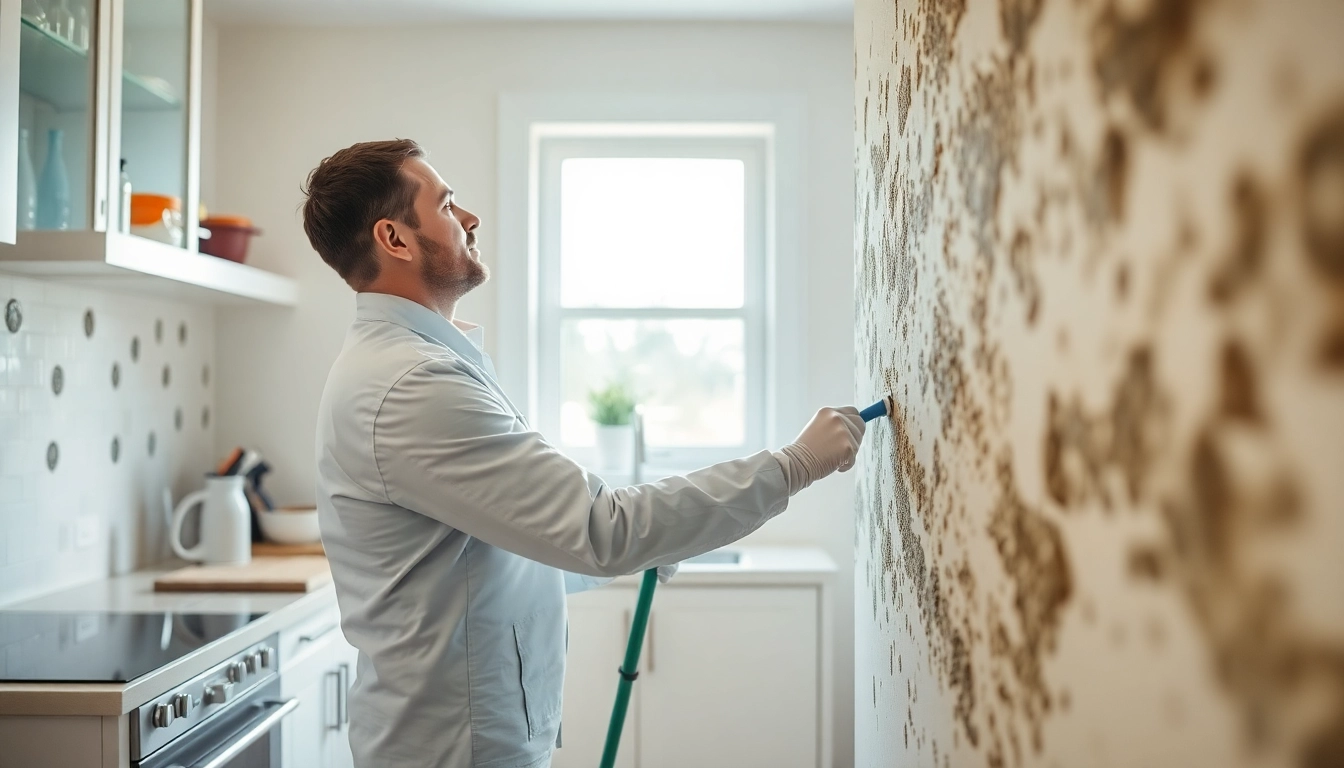Understanding Mold and Its Risks
Mold is a type of fungus that thrives in damp, warm environments. It plays a crucial role in the ecosystem by breaking down organic matter, but in an indoor setting, it can pose significant health risks. Understanding mold, its growth conditions, and associated health risks is essential for homeowners looking to maintain a safe and healthy living environment. Effective Mold removal strategies are vital in combating this persistent issue.
The Nature of Mold
Mold is composed of tiny cells called spores that float in the air. When these spores land on a suitable surface, such as wood, drywall, or carpeting, and the conditions allow—primarily moisture, warmth, and organic material for nutrition—mold can begin to grow. Mold can appear in various colors, including black, green, white, or orange. The most concerning types of mold that grow indoors include black mold (Stachybotrys chartarum), known for its potential health risks, and Aspergillus, which can cause allergic reactions.
Common Health Risks Associated with Mold
Exposure to mold can lead to a range of health issues, particularly respiratory problems. Individuals with asthma, allergies, or compromised immune systems are at greater risk. Symptoms of mold exposure may include:
- Respiratory issues (coughing, wheezing, shortness of breath)
- Allergic reactions (sneezing, runny nose, skin rashes)
- Chronic headaches
- Eye irritation
In severe cases, mold exposure can contribute to more serious conditions, such as lung infections or other pulmonary diseases. Therefore, understanding and addressing mold issues promptly is crucial for health and safety.
Mold Growth Conditions
For mold to thrive, several conditions must be met:
- Moisture: Mold requires a moisture source, which can come from leaks, flooding, or high humidity levels.
- Temperature: Most molds prefer warm environments, typically between 77°F and 86°F.
- Nutrients: Mold feeds on various organic materials, such as wood, paper, and fabrics.
- Time: Given the right conditions, mold can begin to grow within 24 to 48 hours.
By addressing these conditions, homeowners can prevent the growth of mold in their homes.
Mold Removal Techniques for Homeowners
Removing mold requires a systematic approach that focuses on identifying the source of moisture and physically removing the mold itself. Below are various methods that homeowners can adopt for effective mold removal.
Essential Tools for Mold Removal
Before beginning any mold removal process, it is vital to equip yourself with the right tools and protective gear. Essential tools include:
- Personal protective equipment (PPE) such as gloves, masks, and goggles
- A solution for cleaning (can include vinegar, bleach, or commercial mold removers)
- Scrubbing brushes and sponges
- HEPA vacuum for thorough cleaning
- Moisture meter to track humidity levels
Having these tools at your disposal can simplify the removal process and ensure safety throughout.
DIY Mold Removal Methods
For small areas of mold growth, homeowners can often manage removal themselves. Here are popular DIY methods:
- Vinegar: A natural mold killer, undiluted white vinegar can be sprayed directly onto moldy areas, left for an hour, and then scrubbed off.
- Bleach Solution: For non-porous surfaces, a bleach solution (1 part bleach to 10 parts water) can effectively kill mold spores. However, it should never be mixed with ammonia or other cleaners.
- Baking Soda: A mixture of baking soda and water can also be used to scrub surfaces and remove mold.
- Hydrogen Peroxide: This is another effective solution, especially for porous materials, as it kills mold spores without leaving harmful residues.
After applying any solution, it is critical to ensure the area is well-ventilated and moisture is adequately managed to prevent future growth.
Professional Mold Removal Services
In cases of extensive mold growth or if DIY methods fail, it may be necessary to call in professional mold removal services. Professionals are equipped with advanced tools and techniques, such as:
- HEPA Filtration: High-efficiency particulate air (HEPA) filters can capture tiny mold spores, preventing them from spreading.
- Controlled Demolition: For severe mold infestations, it might be necessary to remove affected drywall or flooring.
- Antimicrobial Treatments: Professionals use specialized products that inhibit the growth of mold in areas prone to moisture.
Professional services not only ensure thorough removal but also decreasing the likelihood of recurrence.
Preventing Mold Growth in Your Home
Once mold is removed, the focus should shift towards preventing its return. Implementing effective moisture control and maintenance strategies is key. Here are some best practices:
Moisture Control Strategies
Reducing moisture is fundamentally essential to prevent mold growth. Here are strategies to control moisture levels:
- Fix leaks immediately to prevent water accumulation in walls, ceilings, or floors.
- Use dehumidifiers in high-humidity areas like basements or bathrooms.
- Ensure proper drainage around the foundation of your home to divert rainwater.
- Seal any gaps around windows, doors, and pipes to prevent moisture ingress.
Maintaining low humidity levels (below 60%) is the goal for any home.
Improving Home Ventilation
Good ventilation reduces indoor humidity levels, crucial in mold prevention. Below are techniques to enhance ventilation:
- Open windows and doors regularly, especially while cooking or bathing.
- Utilize exhaust fans in kitchens and bathrooms to expel excess humidity.
- Consider installing vents in crawl spaces and attics to allow for air circulation.
- For homes with inadequate ventilation, adding windows or vents may help improve airflow.
Improved ventilation not only helps keep humidity levels low, but also promotes a healthier atmosphere.
Regular Maintenance Tips
Monitoring and maintaining your home is vital in the struggle against mold. Here are some tips:
- Inspect potential problem areas regularly, such as basements, bathrooms, and kitchens.
- Clean gutters frequently to ensure proper water flow and avoid overflow.
- Perform routine checks on HVAC systems and filters to minimize mold spore circulation.
- Replace any roofing or siding that has degraded to prevent water infiltration.
Regular maintenance makes it easier to catch potential mold problems before they escalate.
Recognizing When to Seek Help
While many mold issues can be remedied by homeowners, certain situations require professional intervention. Recognizing these situations can save both time and health risks.
Signs You Need Professional Mold Removal
It is time to seek help when the following signs are present:
- Widespread or persistent mold growth covering more than 10 square feet.
- Visible mold in areas with significant moisture, such as under sinks or behind walls.
- Persistent health problems among residents that correlate with specific areas of the home.
- Unusual odors in the home pointing to hidden mold issues.
Prompt action not only simplifies the process but ensures safety for inhabitants.
Understanding Mold Remediation vs. Removal
Mold removal and remediation are terms often used interchangeably, but they have distinct meanings. Mold removal is the process of physically eliminating mold from a surface, while mold remediation encompasses a more comprehensive approach. It involves identifying and correcting the issue that caused mold growth, cleaning contaminated areas, and implementing prevention measures to stop it from returning. Understanding this difference is crucial when discussing needs with a professional.
Cost Considerations for Mold Services
The cost of mold removal or remediation can vary widely based on several factors:
- Extent of the mold problem and affected areas
- Type of mold threatening the home
- Amount of preparatory work required beforehand
- Geographical location and availability of services
Typical costs can range from several hundred to thousands of dollars, depending on the complexity of the situation. Always seek quotes and consult with multiple professionals, if necessary, to find a service that fits your requirements.
Long-term Solutions for a Mold-Free Environment
Creating a mold-free environment is an ongoing responsibility and requires vigilance even after initial removal and remediation. Here are effective long-term strategies:
Using Mold-Resistant Products
When building or renovating, consider using mold-resistant materials. These include:
- Mold-resistant drywall: Specifically designed to resist moisture penetration.
- Mold inhibitors: Chemicals that can be added to paints and primers to resist mold growth.
- Water-resistant flooring: Opt for materials that are less likely to support mold growth, such as vinyl or tile.
Using such materials can significantly reduce the risk of mold in new or renovated spaces.
Routine Inspection and Monitoring
A routine inspection can help keep mold at bay. Consider implementing the following practices:
- Schedule seasonal inspections in high-risk areas of the home.
- Invest in a moisture meter to keep track of humidity levels throughout the year.
- Conduct air quality testing if unexplained mold growth or odors occur.
Routine monitoring enables early detection of any mold issues, mitigating potential risks and damages.
Staying Informed About Mold Risks
Education is essential for prevention. Homeowners should prioritize learning about mold, its risks, and the latest in mold prevention strategies. Utilize resources from local health departments, educational institutions, and community workshops. Stay informed regarding advances in mold treatment technologies and approaches.
By staying informed and adopting proactive measures, homeowners can create a safer and healthier living environment, effectively combatting mold and its associated risks.


